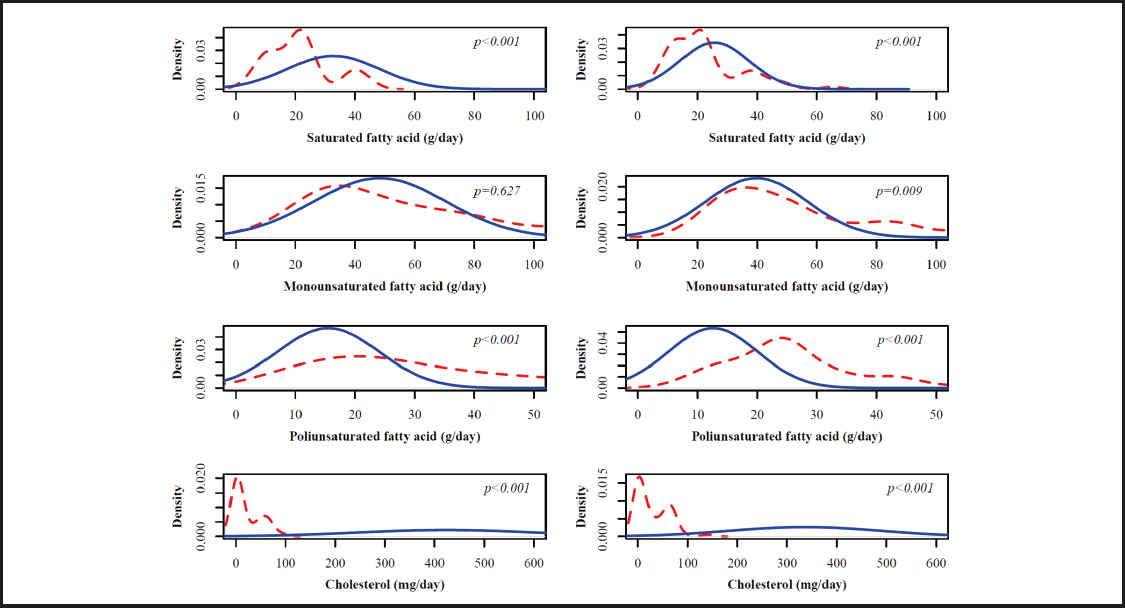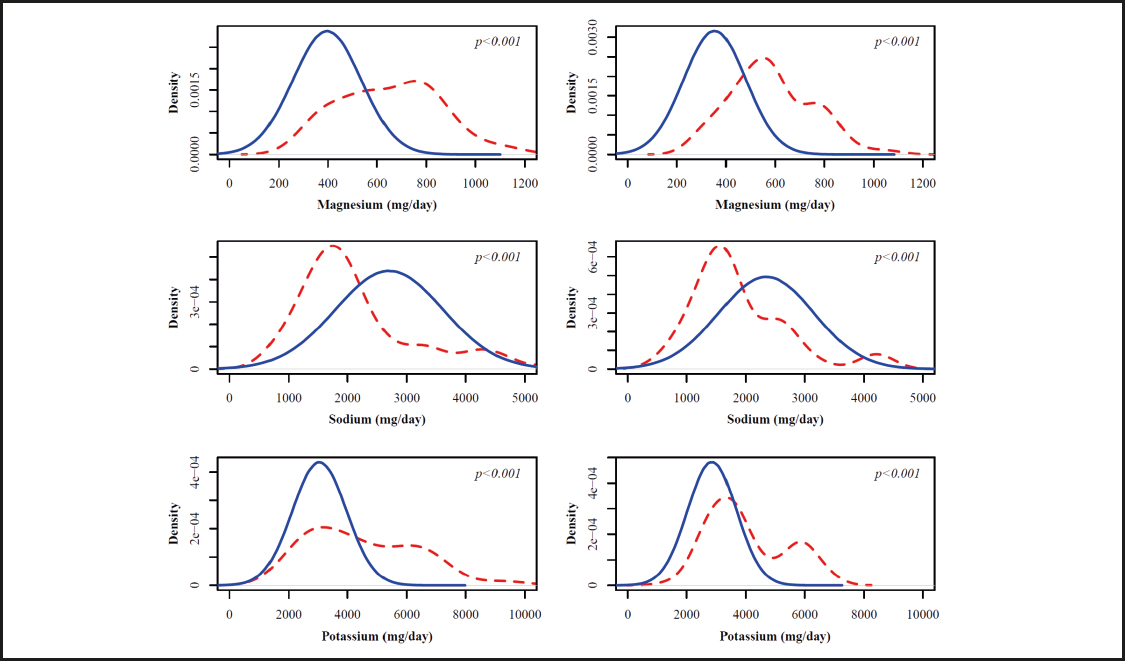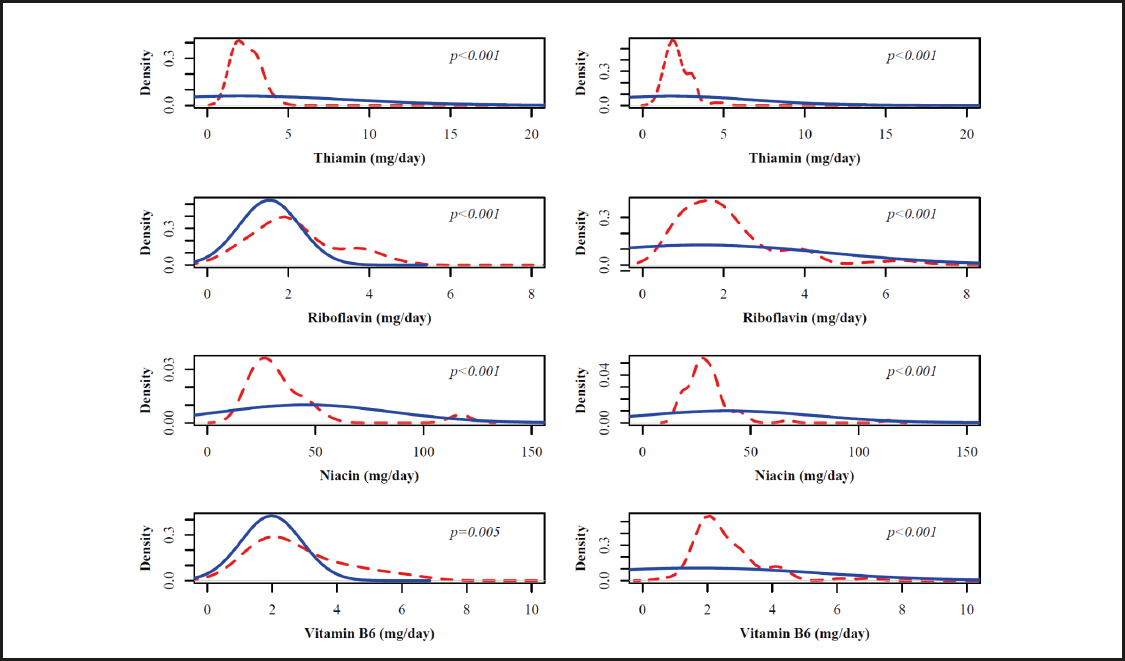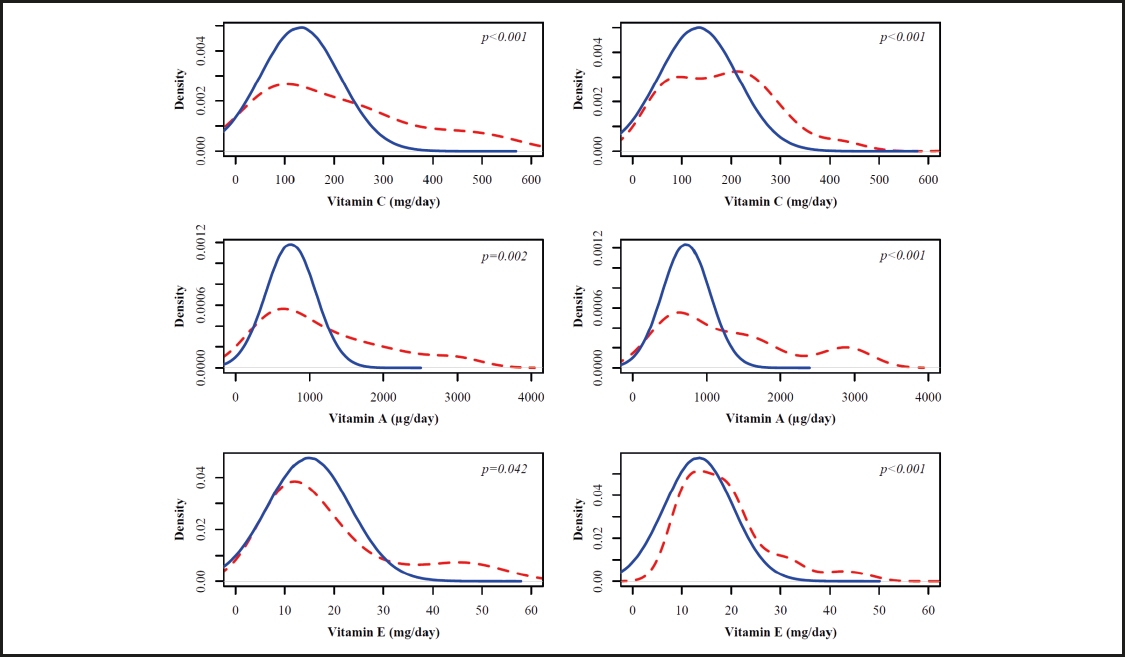INTRODUCTION
Veganism or strict vegetarianism implies the non-use or consumption of products and services from another species (1). From the year 2000, vegan food became popular after being adopted by some endurance sports athletes, as did the consumption of uncooked vegetables (raw veganism) (2).
In Spain, no official data exist regarding the vegan population. The figures available from the Spanish Vegetarian Union indicate that 1.5 % of the general population over 18 years of age does not eat fish or meat, without further specification, with young people with secondary or higher education showing the greatest interest in vegetarianism (3). Various studies have been published in Europe, estimating that less than 1 % of the population follows this type of diet (4-6).
Studies have determined that a diet rich in vegetables provides health benefits, primarily to prevent cardiovascular disease and cancer (7,8). However, these studies have included ovo-lacto vegetarians and vegans in their statistical analyses. Other studies, though, have made this distinction, with statistically significant differences being found between the vegan and omnivorous populations with vegans having a lower body mass index, lower prevalence of type 2 diabetes mellitus, and a lower incidence of all types of cancer. All-cause mortality, however, was not lower in the vegan population and they had a higher incidence of urinary tract cancer (9,10). Furthermore, all these results are derived from observational studies, and very recently a clinical trial assessed the effectiveness of the vegetarian diet compared to the Mediterranean diet with respect to metabolic profile, finding that both diets were very similar except that the vegetarian diet reduced low-density lipoprotein cholesterol by 9 mg/dl versus the Mediterranean diet and, by contrast, the vegetarian diet increased triglycerides by 13 mg/dl (11). To our knowledge, however, no similar studies have distinguished the vegan diet from the ovo-lacto vegetarian diet.
Strictly vegetarian diets tend to be higher in dietary fiber, magnesium, folic acid, vitamin C, vitamin E, iron and phytochemicals and lower in calories, saturated fat, cholesterol, long-chain omega-3 fatty acids, vitamin D, calcium, zinc and vitamin B12. Among the main concerns are the low protein content and/or its quality, the absence of vitamin B12 (12), the need to ensure an adequate intake of vitamin D, as its deficiency has been proven and associated with an increased risk of bone fractures and lower bone mineral density (13,14), in addition to the bioavailability and absorption of iron from plant foods, with some studies showing that the iron reserves of vegans tend to be lower (15). Concerning essential fatty acids, omega 6 is present mainly in vegetable oils and nuts, and thus its deficiency is not a problem in vegans. Omega 3, however, is abundant primarily in fatty fish, and it is therefore also important to study its possible deficiency (16).
Regarding the analysis of the intake of macronutrients and micronutrients in the vegan population, several studies have been published in northern and central Europe comparing the mean intake in the vegan population with that of the general population or in some cases with that of non-strict vegetarians. It should be noted that some of these studies did not distinguish between men and women, a key factor in the analysis of nutrient intake. In our literature search we found no studies conducted in a Mediterranean population, and given the importance of this type of diet compared to a vegetarian diet (11), we carried out a study to determine whether there were differences in macronutrient and micronutrient intake in a country where the accessibility of fruits and vegetables and traditional cuisine allows this type of diet to be easily followed, as is Spain. We also differentiated between men and women, studying the distributions of nutrient intake instead of mean values, as vegans with nutritional deficiencies may take supplements that distort the normality of the data.
MATERIALS AND METHODS
STUDY POPULATION, DESIGN AND PARTICIPANTS
The study sample was collected from the adult population of Spain, both omnivorous and vegan. This cross-sectional study included a sample of Spanish vegans who voluntarily chose to participate in the study to determine macronutrient and micronutrient intake. To obtain this sample, letters of presentation of the study were sent in 2015 to various Spanish vegan associations (Alicante, Valencia, Madrid and Barcelona) and the project was presented at the Vegan Festival held in Alicante in 2015, which was attended by vegans from all across Spain. Those who did not sign the informed consent or those who had been vegans for less than one year at the time of the invitation to participate were excluded from the study. To reach as many participants as possible, during the collection year the above-mentioned vegan associations were reminded quarterly to forward the study information to their members. Thus, the design used was snowball sampling.
To compare the macronutrient and micronutrient distribution in the general Spanish population, data from the Spanish Agency for Food Safety and Nutrition were used which, based on the results of the 2011 Spanish National Dietary Intake Survey and data from the Spanish Food Composition Database (18-20), calculated the mean daily intake and standard deviation of each macronutrient and micronutrient. A normal distribution of each of the nutrients was assumed, as the population was large and the parameters were biological.
All participants signed the informed consent form before completing the survey. The data collected were anonymized and evaluated statistically with no possibility of nominal allocation. The project was approved by the Project Evaluation Office of Miguel Hernandez University on March 17, 2015 (ref: DFP.ECC.01.15).
The availability of the data supporting the findings of this study is restricted, and used under license for the current study and, therefore, are not publicly available. However, the data could be used upon reasoned request and with the permission of the Project Evaluation Office of the Miguel Hernández University.
VARIABLES AND MEASUREMENTS
All participants were asked about their dietary intake for the previous day. The foods expressed in this survey along with the approximate amounts ingested were entered into the DIAL program (21), which determines the total amount of macronutrients and micronutrients ingested. This program was developed by the Complutense University of Madrid and its use is valid for this purpose (22). For foods not registered in the program database, their nutritional composition was used, based on the composition appearing on the labeling.
The variables sex, age, weight, height and intake for the last 24 hours were collected, including the use of nutritional supplements. The intake was measured by means of the reminder of the previous 24 hours by means of a self-completed survey, including all supplements in quality and quantity. Body mass index (BMI) was calculated from weight and height (self-reported).
STATISTICAL ANALYSIS
Data were obtained on the distribution of all macronutrients and micronutrients in the Spanish adult population (mean and standard deviation) (18,19), assuming that these followed a normal distribution. Data from the vegan sample and the Spanish population were described, indicating means and standard deviations. Each of the distributions was compared with that of subjects following a vegan diet, using the Kolmogorov-Smirnov test. This analysis was performed stratified by sex, as intake is generally higher in men. The type I error was set at 5 % and the statistical package used was R 3.5.1.
RESULTS
The nutrient intake of 102 vegans was analyzed, 67 of them women (65.7 %), with a mean age of 32.7 ± 10. years. Analysis of both groups showed that the men were older than the women (36.3 ± 10.2 vs. 30.8 ± 9.5 years; p = 0.008) and their BMI was also higher (25.0 ± 4.8 vs. 21.2 ± 2.9 kg/m2; p < 0.001).
Table I displays the distribution of macronutrients and micronutrients, differentiating between men and women, and the general or vegan population. The table shows that the only nutrient distributions that did not differ significantly (p > 0.05) from the general population were proteins in both men and women, fats in women only, and MUFAS in men.
Table I. Nutrients distribution in vegans and the general population in Spain

MUFA: monounsaturated fatty acids; PUFA: polyunsaturated fatty acids; SFA: saturated fatty acids.
With respect to macronutrients (Fig. 1), in the vegan population both sexes consumed more carbohydrates. Conversely, total fat intake was lower in vegan women. Lower fat intake was also seen in vegan men, although not reaching significance (p = 0.086). Figure 2 illustrates that fiber intake was clearly higher in the vegan population. Analysis of the fat intake profile revealed that individuals who followed a vegan diet had a lower intake of saturated fatty acids, a somewhat higher intake of monounsaturated fatty acids (only women), a higher intake of polyunsaturated fatty acids, and much lower cholesterol intake (Fig. 3).

Figure 1. Carbohydrate, lipid and protein intake distributions in vegans and in the general population. Left, men; right, women; blue, general population; red, vegans.

Figure 2. Fiber intake distribution in vegans and in the general population. Left, men; right, women; blue, general population; red, vegans.

Figure 3. Saturated fatty acid, monounsaturated fatty acid, polyunsaturated fatty acid and cholesterol intake distributions in vegans and in the general population. Left, men; right, women; blue, general population; red, vegans.
Regarding the main minerals, a lower intake of calcium and iodine and a higher intake of iron were noted in the vegan population (Fig. 4). Concerning vitamins (Fig. 5), among vegans there was a much lower intake of vitamins B12 and D, and an increased intake of folic acid. The rest of the micronutrients are shown in figures 6 -9, which emphasizes that the vegan population has a lower intake of thiamine, riboflavin, niacin and vitamin B6, but a higher intake of vitamins A, C and E.

Figure 4. Calcium, iron and iodine distributions in vegans and in the general population. Left, men; right, women; blue, general population; red, vegans.

Figure 5. Vitamin B12, vitamin D and folic acid intake distributions in vegans and in the general population. Left, men; right, women; blue, general population; red, vegans.

Figure 6. Magnesium, sodium and potassium intake distributions in vegans and in the general population. Left, men; right, women; blue, general population; red, vegans.

Figure 7. Zinc, selenium and phosphorus intake distributions in vegans and in the general population. Left, men; right, women; blue, general population; red, vegans.
DISCUSSION
The study design has been carried out to compare the intake of vegans against the general Spanish population, given that food availability is very different, in populations with socio-economic, cultural, climatic, etc. very different. Our analysis of the diet of Spanish vegans revealed many differences compared to that of the general population, especially in micronutrients and vitamins. Regarding minerals, vegans had calcium and iodine deficiencies. Additionally, a significant percentage of vegans were found to be deficient in vitamins B12 and D compared to the general Spanish population.
STRENGTHS AND LIMITATIONS OF THE STUDY
The main strength of this study is that it is the first of its kind to analyze the distributions of each of the nutrients, rather than the mean values. This is an important issue, since there is a high likelihood of this type of population taking nutritional supplements, which would alter the mean values. Furthermore, to the best of our knowledge, this is a novel type of study in Spain, carried out with a representative sample of the group, recruited through national forums. It should also be noted that the number of participants (n = 102) was higher than in other European studies.
The main limitation is that the data on food intake were self-reported and recalled from what was consumed the previous day. Nonetheless, this information bias is common to all food intake studies and is generally underestimated. Consequently, deficiencies may be higher than those found here, although in this study our comparison was with the general population in which intakes were established using a similar method (18,19). In addition, the databases for the calculation of nutrients are different, which can pose comparison problems. Another limitation is that the sample was not taken at random, but rather from all volunteers, with the intention of involving the highest number of individuals. Accordingly, to enable as many vegans as possible to become aware of the study, a notification was prepared and mailed to all the national associations and presented at the most important meetings held during the period of sample collection.
COMPARISON WITH THE EXISTING LITERATURE
The ANIBES study (Anthropometry, Intake and Energy Balance in Spain), undertaken in 2016, analyzed a representative sample of the general Spanish population, finding that macronutrient intake contains 41.1 % energy from carbohydrates, which is lower than all the recommendations. Fats, however, are well above the recommended intake, with 38.5 % in total fats, 11.7 % of which are saturated. In both cases, these figures are much higher than the current recommendations. Protein intake is 16.8 % (a value near the recommendations) but comes mainly from meat and sausages, with a decrease in the traditional consumption of fish and legumes in the Mediterranean diet (17).
When comparing our results, we could only focus on the mean values of each nutrient (Table I), since other similar studies did not examine the distributions. To facilitate this comparison, as there are a large number of nutrients, in the Online Resource we show the differences between the vegan and omnivorous populations in the studies found (4-6,23-25). Below we detail only the differences found compared to our results.
Regarding macronutrients (Online Resource), the protein intake in all countries was lower in the vegan population, except in our study in which it was the same. These differences could be due to the fact that in Spain, as a Mediterranean country, the consumption of legumes is higher in both the omnivorous and vegan populations. As a result, animal protein is replaced with vegetable protein. When we compared total fat intake, we found that in Spain the vegan population had a higher intake than the omnivorous population, as in Switzerland (6), compared to other countries where consumption was lower. In our study, fat intake was clearly influenced by an increased consumption of olive oil, used both raw and in cooking, which is associated with a higher intake of monounsaturated fatty acids.
Analysis of mineral salts revealed a lower consumption of iodide, similar to that of the other countries examined, with the exception of France (Online Resource). This could be due to the soil composition in Spain being very poor in iodine, making supplementation necessary even for the general population. This was also true of zinc. In addition, we found that potassium consumption in the United Kingdom is different from the rest of the countries (23). Sodium is more complicated to interpret as salt can be added during cooking.
Analysis of vitamin intake (Online Resource) showed fewer differences than the rest of the nutrients. A higher intake of riboflavin was found in vegans, similar to that of Switzerland, compared to a lower intake found in the other studies. In our study, this was undoubtedly due to a higher consumption of almonds, a distinctly Mediterranean fruit, and lentils, a legume widely consumed throughout Spain. Conversely, intake of vitamin B6 in the United Kingdom was lower in vegans than in the omnivorous population (23), while in the rest of the countries it was higher. Finally, it should be noted that the vegan diet in all cases was much lower in cholesterol, saturated fat, calcium, vitamin B12 and vitamin D (4-6,23-25), which can lead to considerable deficiencies among the vegan population, and it would therefore be advisable to raise awareness in this group concerning the need for supplements aimed at avoiding such deficiencies. There was also a clear increase in the amount of fiber consumed by this population, which has clear health benefits.
IMPLICATIONS TO RESEARCH AND PRACTICE
These results have serious implications as they provide evidence of the need for nutritional supplements, or foods fortified with calcium, iodine, and vitamins B12 and D. Given the rise in the number of people adopting a vegan diet, an important field of research has opened up with regard to this population in all areas related to lifestyle, the motivation for adopting these eating habits and their short-term repercussion on quality of life and health issues.
CONCLUSION
As a result of the deficiencies found, Spanish vegans need nutrition advice to ensure their diet contains the necessary supplements. Women, due to their specific characteristics, particularly in the reproductive years, should have their diet monitored by health professionals. It should be noted, however, that the diet of Spanish vegans is low in cholesterol and high in fiber, both of which have healthy features worthy of mention.
















